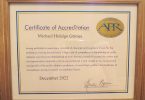I had a good idea of what was ahead. When I decided to take the APR plunge last year, I was a longtime PRSA member and not a rookie PR pro. So I knew the three basic parts would be, in my view, a series of essays about a campaign you participated in and your career in general, a presentation of your campaign to a panel of peers and a standardized examination.
Surprisingly, the most difficult of these was one I thought I would be a natural for: the essays for the 14 questions in the Panel Presentation questionnaire. As a PR writer, I write any number of articles, blog posts, white papers and social media updates daily, so I expected to be well prepared for this part.
Instead, I had a grueling time for two reasons. First, the open-ended nature of the questions and lack of a word limit made it challenging to include the best details and still keep the response focused. Second, the sheer number of questions and the detail needed for the campaign responses required a more long-range approach than I anticipated.
Based on this, I distilled four lessons that may help other candidates tackle this part more efficiently. The Panel Presentation responses form the first and foundational part of the APR process, and completing them proficiently is crucial for not just being well prepared for the presentation and examination, but for saving yourself a lot of time and work. I hope these tips help.
- Focus on the campaign questions first. It’s tempting to want to start with the nine questions about your career, but don’t. They’re listed first, they’re easier and they’re useful for getting warmed up. But the five campaign questions are far more important and form the basis for your Panel Presentation later. Importantly, these questions require hard work in the form of reviewing and synthesizing details from your campaign, whereas the other questions mainly involve expressing viewpoints on your career.
- Try to impose some word limit. This is difficult, but without some baseline it’s easy to lose sight of a clear answer and also adds hours of unnecessary work. The APR guide says the average candidate spends about eight to 10 hours on the responses, but that can encompass a range of word lengths. For what it’s worth, the average length for my career-question responses was 546 words; the average for my campaign responses was 852. Try to set at least some length to work toward.
- Try to apply the RPIE framework. Not only will using the research–planning–implementation–evaluation model provide a solid format for addressing a question, it will give you excellent practice for inculcating this mindset for your presentation and examination, in which RPIE is crucial. Another tip that can give you fodder for your responses is to zero in on all the things in your career that especially frustrated you and you wish could have been handled differently, and critique those things through the lens of RPIE to describe how you would have made improvements.
- Find a mentor to review your responses. Finally, bringing in the cold eye of a veteran APR is perhaps the best way to ensure the quality of your responses. Work with your Chapter to get placed with a mentor, and be sure to build in time for this review so finishing the writing won’t take precedence. In addition to offering a critical evaluation of the strategy of your content, your mentor will serve as an expert check against grammar and style blemishes.
Best of luck to all candidates with the Panel Presentation questionnaire!
For more information about the Accreditation in Public Relations process, visit www.praccreditation.org.
Joseph Priest, APR, is a corporate writer at Syniverse, a mobile solutions company in Tampa, Florida. He co-manages Syniverse’s blog and social media, and can be reached at joseph.priest@syniverse.com.







